Key takeaways:
- Trust in journalism is essential for creating informed audiences and maintaining the media’s credibility.
- Building rapport and maintaining relationships with sources through active listening, transparency, and regular communication fosters deeper insights and storytelling.
- Identifying reliable sources involves verifying credentials, cross-referencing information, and understanding their motivations.
- Emphasizing empathy and mutual understanding is crucial in developing trust and ensuring sensitivity in reporting personal stories.
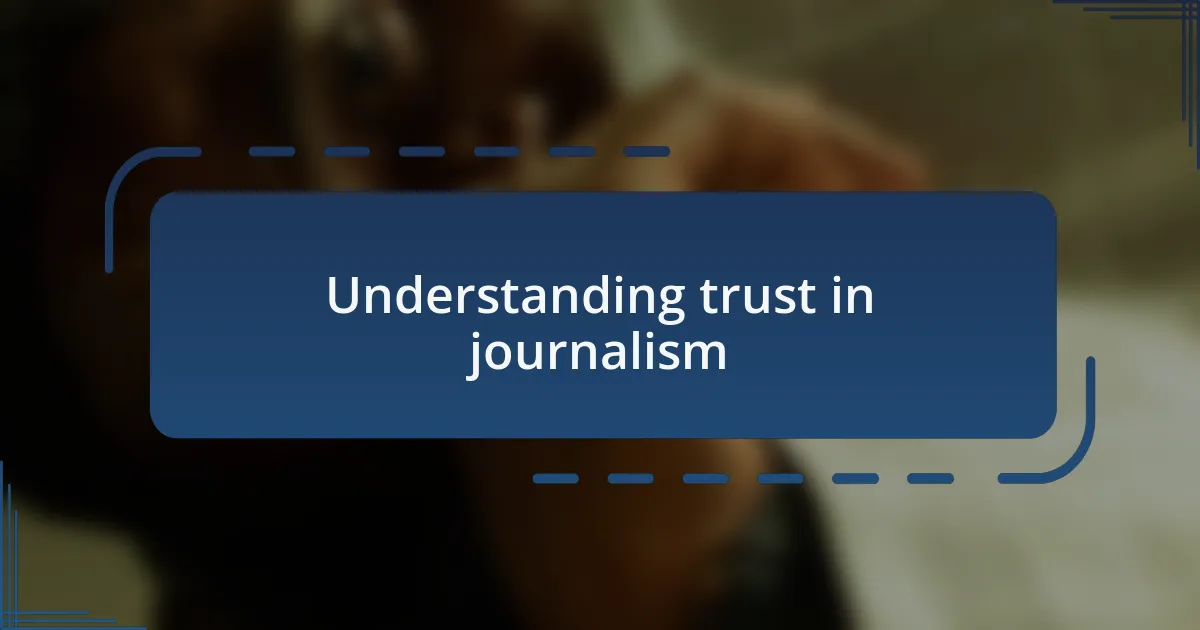
Understanding trust in journalism
Trust in journalism is foundational to the relationship between media and the audience. I recall a time when I received an unsolicited tip from a source about a local event. Initially skeptical, I took the time to verify the details, which reaffirmed my belief in diligence and transparency; this experience deepened my respect for authentic journalism.
When you think about it, who doesn’t want to make informed decisions based on reliable news? The emotional weight of knowing that our choices are influenced by the information we consume can be immense. A personal connection to a story can drive engagement, but it also means that the responsibility to uphold truth lies heavily on the journalists’ shoulders.
Building that trust is not just about fact-checking; it’s about creating a bridge of credibility. I’ve seen firsthand how sharing my process with readers—like discussing how I vet my sources—fosters a deeper understanding and appreciation. After all, isn’t our collective goal to support a media landscape where trust isn’t just earned but felt?

Importance of trust with sources
Establishing trust with sources is vital because it fundamentally influences a journalist’s credibility. I remember instances when I had the opportunity to work closely with multiple sources on a breaking story. The more I ensured their privacy and truly listened to their concerns, the more they opened up, sharing insights that enriched the narrative. Isn’t it fascinating how trust can transform a simple exchange into a robust story filled with depth?
When sources trust a journalist, it often leads to a more comprehensive understanding of the story, allowing for nuanced reporting. I’ve felt the power of this firsthand; one source, who had initially been cautious, eventually provided me with critical information that brought the story to life. It left me pondering: how much more value can we uncover when we nurture these relationships? Trust isn’t just a courtesy; it unlocks the potential for deeper conversations and more impactful journalism.
Moreover, maintaining trust with sources safeguards the integrity of the information shared with the public. I always remind myself that a single misstep can erode years of effort in building those connections. The emotional weight of knowing that my actions could significantly impact someone’s life keeps me grounded and vigilant. Isn’t it our duty to protect that bond, ensuring that the voices we amplify are not just heard, but respected?
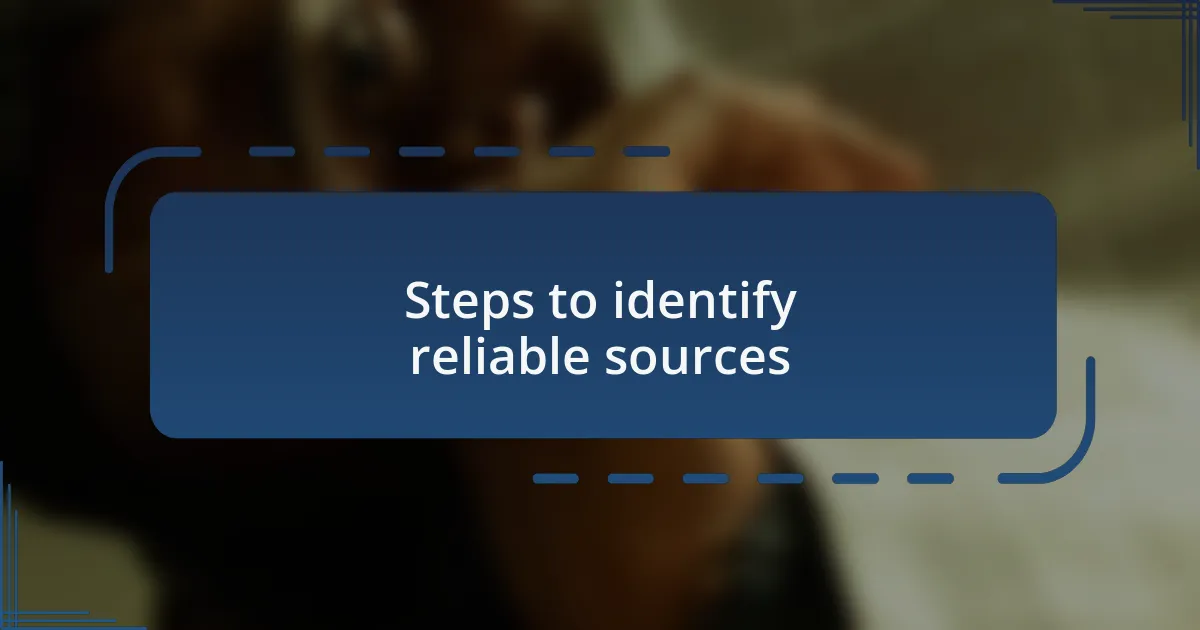
Steps to identify reliable sources
To identify reliable sources, I always start by verifying their credentials. It’s essential to check what experience or expertise they bring to the table. For instance, when I covered a complex legal issue, I reached out to a well-respected legal expert. Their background not only lent credibility to the story but also provided nuanced insights that shifted my understanding of the topic.
Another practical step is to cross-reference information from multiple sources. I’ve found that when different individuals corroborate the same details, it builds a solid foundation of trust. I recall a time when I was reporting on a local scandal; by speaking to various witnesses, each sharing consistent accounts, I could paint a more accurate picture. That experience taught me how essential it is to piece together each source’s perspective instead of relying on a single story.
Lastly, I assess the motives behind the information shared. Understanding why a source is speaking out can reveal much about the truthfulness of their claims. I once encountered a source who was eager to share their side of a story that put them in a negative light. I realized that their honesty reflected a genuine desire to set the record straight, showcasing how sometimes the most reliable sources are those willing to take risks for accountability.
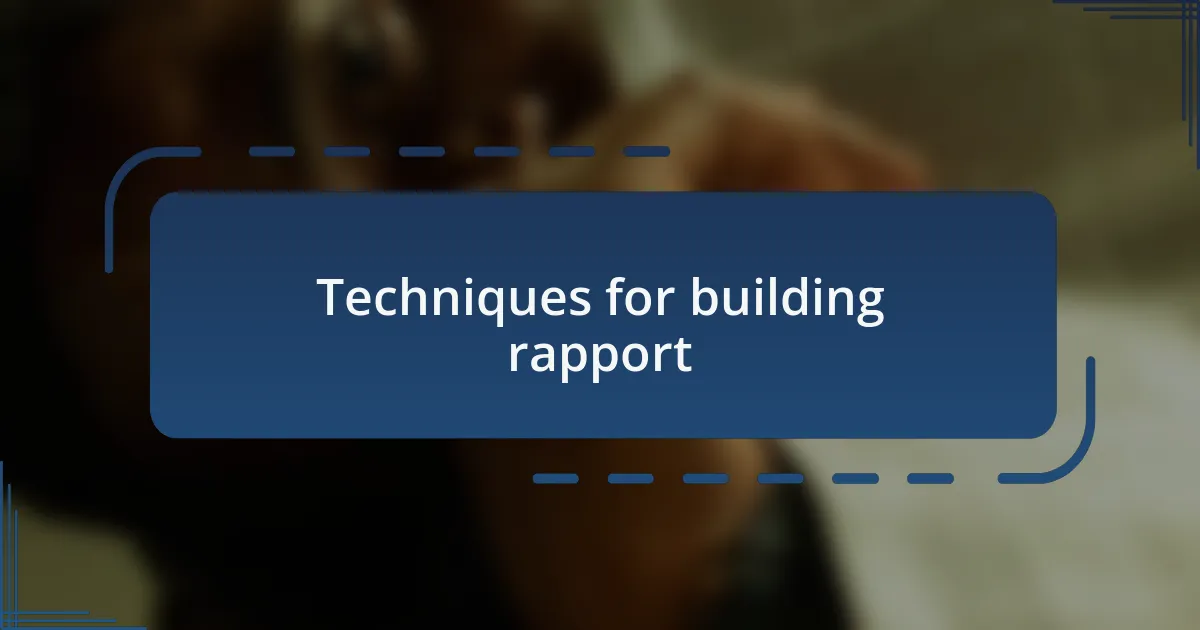
Techniques for building rapport
Building rapport with sources is crucial to fostering trust and openness. One effective technique I’ve adopted is active listening. I make a conscious effort to really hear what my sources are saying, not just waiting for my turn to talk. For example, during an interview with a community leader, I noticed that my genuine interest in their story made them more willing to share personal anecdotes, enriching the narrative I was writing. Doesn’t it make you reflect on how attention can unlock a wealth of information?
Another approach that works wonders is finding common ground. When I first approached a reluctant source, I mentioned our shared experiences in local journalism. This small gesture not only eased their apprehension but also transformed our interaction into a collaborative exchange. I felt that connection grow, and as we shared laughs and stories, their willingness to provide insights increased significantly. Don’t you think connections like that can lead to uncovering deeper, more authentic stories?
Consistency is also a valuable tool in building rapport. I make it a habit to follow up with sources, even when I’m not actively working on a story. Whether it’s a simple message checking in or sharing how their insights helped shape my reporting, these gestures remind the source that I value our relationship. I recall a source who initially seemed skeptical; after a few check-ins, they opened up about their concerns surrounding a highly sensitive topic. Their trust in me grew, and it taught me that investing time in relationships pays off immensely in the end.
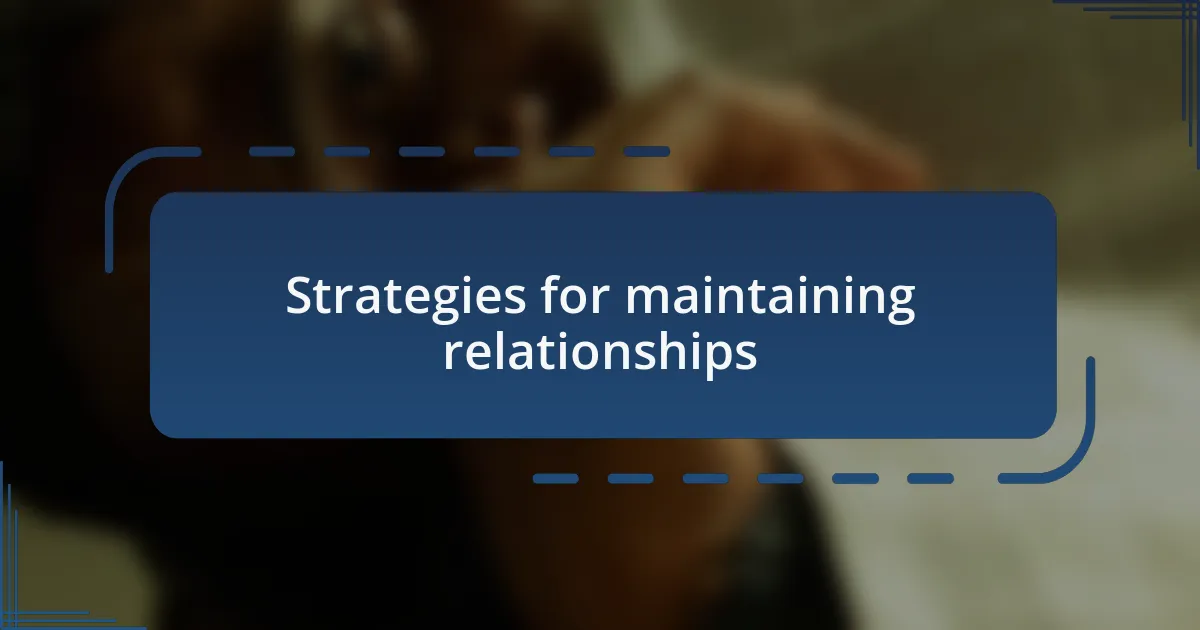
Strategies for maintaining relationships
Establishing a routine for communication can greatly enhance relationships with sources. I often schedule regular follow-ups to discuss ongoing developments or simply to share news that might interest them. Just the other day, I reached out to a former source to provide them with updates about a project we had discussed previously. That small gesture sparked a rewarding conversation, reinforcing our connection. Have you ever noticed how a simple “How have you been?” can open doors to deeper discussions?
Transparency is another critical strategy I embrace to maintain healthy relationships. I consistently share how I will use the information they provide and clarify what can and cannot be made public. I remember a time when a source was apprehensive about sharing sensitive details. Once I explained my commitment to ethical reporting, their anxiety faded, and they became more forthcoming. This level of openness not only strengthens trust but also encourages sources to feel more invested in the stories we create together. Isn’t it fascinating how knowledge can empower your sources?
Lastly, expressing gratitude goes a long way in maintaining relationships. After interviews or important insights, I make it a point to send a quick thank-you note or email. Last week, I did this with a source who shared their personal experiences in a touching interview, and their heartfelt response reinforced the bond between us. It’s incredible how acknowledging someone’s contribution can foster goodwill and pave the way for future collaboration. Have you ever thought about how much a simple thank-you can mean?
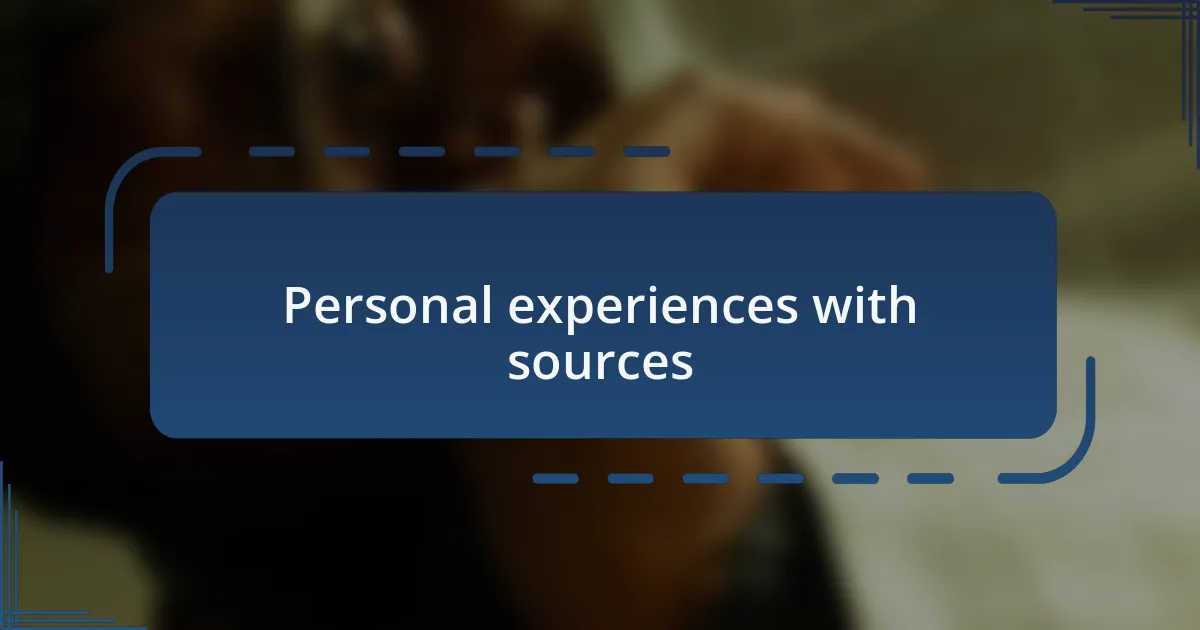
Personal experiences with sources
Building trust with sources often comes down to shared experiences and mutual understanding. I once worked with a whistleblower who initially felt isolated and anxious about being in the spotlight. By just listening to their concerns and validating their feelings, I realized how crucial empathy is in these relationships. It made me wonder: how often do we truly pause to understand the human behind the information?
One of my most memorable experiences was when a source hesitated to share critical data due to fears of retaliation. I assured them that their identity and concerns were my top priority. In doing so, I felt a shift in our dynamic; the source began to open up more freely. This taught me that fostering trust isn’t just about information exchange—it’s about creating a safe space for vulnerability.
Another time, a source shared a deeply personal story during our conversation. After we wrapped up, I felt a responsibility not only to report accurately but also to honor their trust by portraying their experience authentically. Reflecting on that moment, I realized how each interaction holds the potential to deepen our relationships. Have you ever felt that pressure of balancing honesty with emotional sensitivity? Each encounter is a chance to reinforce trust, and I’ve learned that authenticity in my responses can make all the difference.
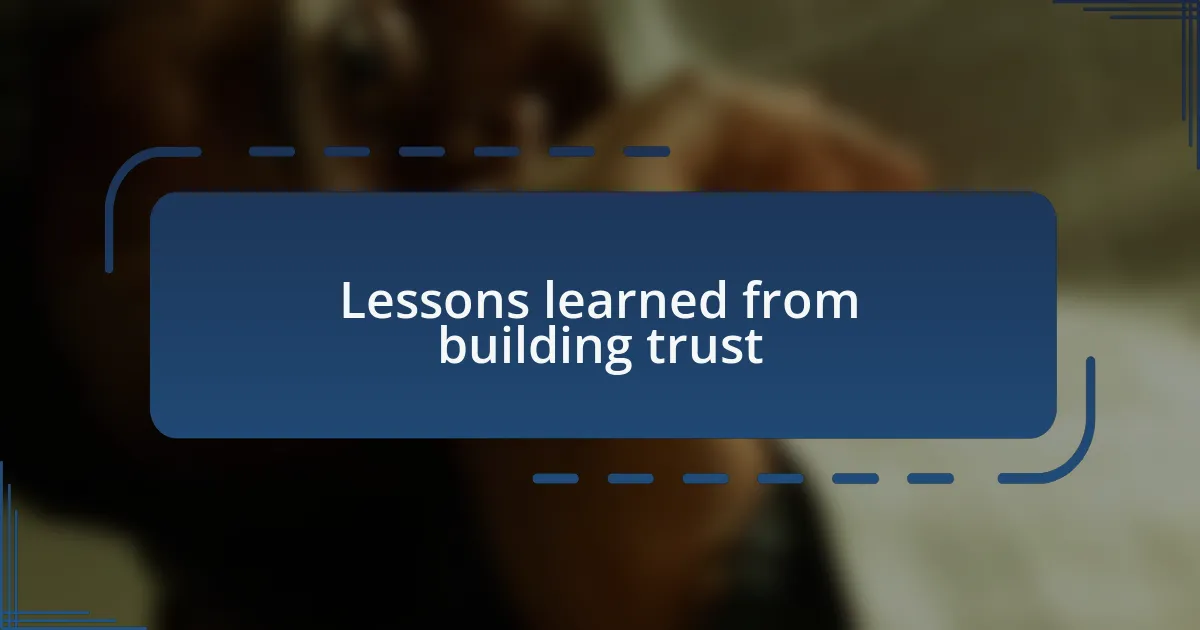
Lessons learned from building trust
There’s a fine line between earnest curiosity and pushing too hard for information. I recall a situation where I was too eager to probe deeper into a source’s background. Instead of gaining insight, I noticed them retreat further into their shell. This experience taught me the importance of pacing—sometimes, giving a source the space they need builds trust more effectively than relentless questioning. How often do we risk losing valuable connections by not recognizing when to step back?
In another instance, I had a source who initially viewed me with skepticism. Our first meeting felt like a dance of cautious movements. Over time, I found that sharing bits about my own experiences helped dissolve those barriers. It was a reminder that trust is often a two-way street: when I opened up, they mirrored that vulnerability. Have you ever noticed how personal stories can shift the dynamics of a conversation?
Lastly, I learned that consistency plays a vital role in cultivating trust. A source reached out months after our initial discussion, seeking advice on a sensitive topic. I made it a point to check in regularly, reinforcing our connection. Seeing their relief in knowing I was there for them, not just for a story, deepened our relationship immensely. It raises the question: how do we ensure our words and actions align with our commitment to our sources?